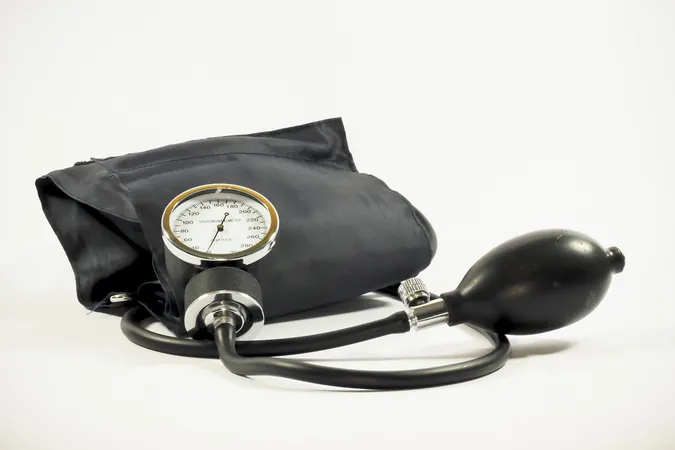
Groundbreaking Study Reveals Systolic BP Under 120 mm Hg Can Slash CVD Risk for Type 2 Diabetes Patients!
2024-11-18
Author: Olivia
Overview
A revolutionary treatment strategy targeting high systolic blood pressure in individuals with Type 2 diabetes has shown remarkable results in lowering the risk of heart attacks, strokes, heart failures, and cardiovascular-related deaths. This groundbreaking study, unveiled on November 16 at the American Heart Association's Scientific Sessions in Chicago, reported compelling evidence favoring an intensive approach to blood pressure management.
Key Findings
Lead author Dr. Guang Ning, a highly regarded expert and professor at Ruijin Hospital in Shanghai, China, emphasized, “For the majority of individuals suffering from Type 2 diabetes, achieving systolic blood pressure levels below 120 mm Hg correlates with a significantly reduced risk of major cardiovascular incidents. These findings advocate for a more aggressive treatment strategy as a preventive measure.”
Statistics and Impact
Statistics indicate that those with Type 2 diabetes have an increased likelihood—up to double—that they will also experience high blood pressure compared to their non-diabetic counterparts. This connection arises because elevated blood sugar levels can damage blood vessels and kidney functions, leading to higher blood pressure readings. In fact, nearly 75% of individuals with Type 2 diabetes may also contend with high blood pressure, as reported by the Centers for Disease Control and Prevention (CDC).
The BPROAD Study
The ambitious BPROAD study aimed to explore whether a more aggressive blood pressure treatment—targeting a lower threshold of under 120 mm Hg—was more effective than the standard approach, which aims for levels below 140 mm Hg. The extensive study involved 12,821 participants who were monitored across 145 locations throughout China. All were diagnosed with Type 2 diabetes and presented with elevated systolic blood pressure, defined as being 140 mm Hg or greater without treatment, or 130 mm Hg or greater while on medication.
Results of the Study
Key findings from the study revealed that participants in the intensive treatment cohort recorded average systolic pressure levels of 120.6 mm Hg over the four-year period, while those receiving standard treatment averaged 132.1 mm Hg. Astonishingly, those in the intensive group realized a 21% reduction in the relative risk of experiencing major cardiovascular events.
Comparative Data
In stark numbers, 393 individuals (1.65% per year) in the intensive group faced non-fatal strokes, heart attacks, or required hospitalization—or tragically died from cardiovascular complications, compared to 492 (2.09% per year) in the standard treatment group.
Safety and Side Effects
While serious adverse effects were largely similar across both treatment groups, incidences of symptomatic hypotension and elevated potassium levels were observed more frequently in the intensive treatment cohort. Dr. Ning pointed out that these results echo previous findings from studies focusing on hypertension alone, confirming the urgent need for updated clinical guidelines that incorporate these new insights into blood pressure management for individuals with Type 2 diabetes.
Study Demographics
Notably, the average age of participants was around 64, with a balanced gender distribution of 45% female and 55% male. Approximately 22.5% had previously reported a cardiovascular disease diagnosis, and all participants exhibited similar baseline health metrics such as blood pressure and body mass index.
Research Timeline
Conducted from February 2019 to December 2021, participants in this vital research tracked their health through regular follow-ups, some even utilizing home blood pressure monitoring during COVID-19 lockdowns when in-person visits were restricted.
Limitations and Future Directions
Though the study opens new doors to understanding blood pressure management in diabetes care, it also comes with limitations, such as the lack of blinding for participants and clinicians, which may affect bias in reporting.
Conclusion
In conclusion, as research continues to unfold, this bold study could redefine clinical practices and recommendations for millions battling Type 2 diabetes. Stay tuned as science continues to unveil breakthroughs that might not only improve health but save lives!



 Brasil (PT)
Brasil (PT)
 Canada (EN)
Canada (EN)
 Chile (ES)
Chile (ES)
 Česko (CS)
Česko (CS)
 대한민국 (KO)
대한민국 (KO)
 España (ES)
España (ES)
 France (FR)
France (FR)
 Hong Kong (EN)
Hong Kong (EN)
 Italia (IT)
Italia (IT)
 日本 (JA)
日本 (JA)
 Magyarország (HU)
Magyarország (HU)
 Norge (NO)
Norge (NO)
 Polska (PL)
Polska (PL)
 Schweiz (DE)
Schweiz (DE)
 Singapore (EN)
Singapore (EN)
 Sverige (SV)
Sverige (SV)
 Suomi (FI)
Suomi (FI)
 Türkiye (TR)
Türkiye (TR)
 الإمارات العربية المتحدة (AR)
الإمارات العربية المتحدة (AR)